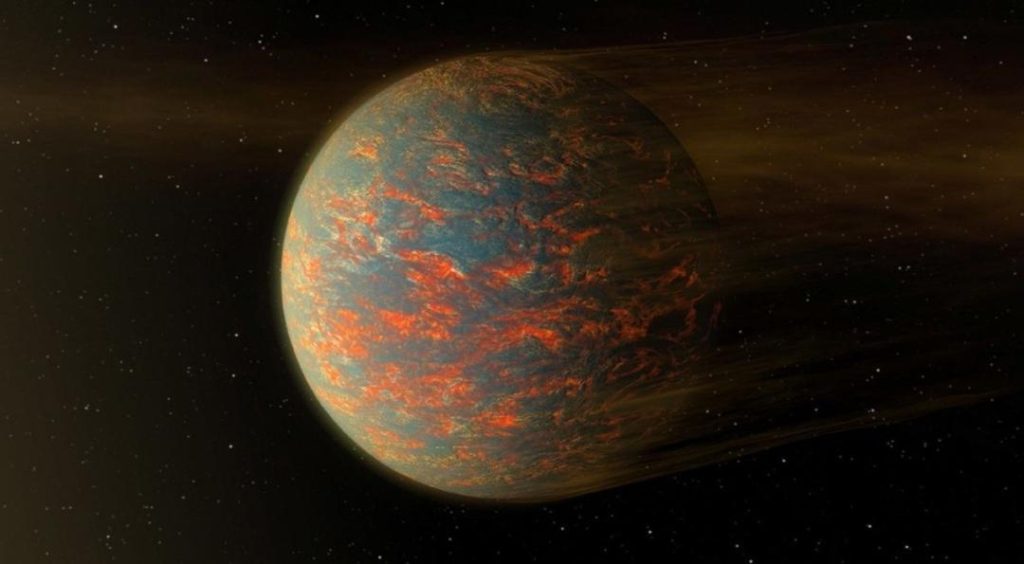
Newly-Discovered Super-Earth Heats Up & Freezes Every 300 Days
A recent discovery has shed new light on the fascinating world of exoplanets, as scientists have found a super-Earth orbiting a Sun-like star 20 light-years from Earth. What’s even more remarkable about this newly-discovered world is its unique ability to swing between extreme climates, experiencing scorching heat for the first part of its year and freezing temperatures for the rest of the days. This phenomenon occurs roughly every 300 days, making it a truly one-of-a-kind planet in our universe.
A ‘super-Earth’ is a planet that is bigger than our own Earth but smaller than the gas giants like Neptune and Uranus. This newly-discovered super-Earth, which has been designated as K2-141b, is estimated to be about 2.4 times larger than our own planet. It orbits its star in an oval shape, which is known as an eccentric orbit. This unusual shape causes the planet to experience extreme variations in temperature, leading to its unique climate pattern.
The discovery of K2-141b was made possible by NASA’s Transiting Exoplanet Survey Satellite (TESS), which has been launched in 2018 to search for exoplanets. TESS uses a unique method to detect exoplanets, which involves monitoring the brightness of stars for any signs of planetary transits. When a planet passes in front of its star, it blocks a small amount of light, causing a mini-eclipse. By analyzing these mini-eclipses, scientists can determine the size and orbit of the exoplanet.
The researchers who made the discovery used a combination of data from TESS and other telescopes to study K2-141b in more detail. They found that the planet takes about 131 days to complete one orbit around its star, which is much longer than the 365 days it takes Earth to orbit the Sun. This longer orbital period is a result of the planet’s eccentric orbit, which causes it to move closer to and farther from its star throughout the year.
As K2-141b moves closer to its star, it experiences extreme heat, with surface temperatures reaching as high as 3,000 degrees Fahrenheit (1,600 degrees Celsius). This is much hotter than the surface temperature of Mercury, which is the closest planet to the Sun in our own solar system. The heat is so intense that it would melt any rock or metal, making it difficult to imagine any life forms existing on the surface of the planet.
However, as K2-141b moves farther from its star, it experiences a sudden drop in temperature, with surface temperatures plummeting to as low as -400 degrees Fahrenheit (-240 degrees Celsius). This is even colder than the surface temperature of Neptune, which is one of the coldest planets in our own solar system. The extreme cold would make it difficult for any liquid water to exist on the surface of the planet, which is a key ingredient for life as we know it.
The discovery of K2-141b provides scientists with a unique opportunity to study the effects of extreme climate variations on a planetary scale. The planet’s unique orbit and temperature fluctuations offer insights into the potential for life to exist on other planets, even those that are much farther away from their stars than Earth.
“This is a fascinating discovery that highlights the diversity of exoplanets and the complexity of planetary formation and evolution,” said Dr. Sara Seager, a planetary scientist at MIT who was involved in the research. “The extreme climate variations on K2-141b offer a unique opportunity to study the effects of climate change on a planetary scale, and to better understand the potential for life to exist on other planets.”
The discovery of K2-141b is just the latest in a series of exciting exoplanet discoveries made possible by NASA’s TESS mission. Since its launch, TESS has identified thousands of potential exoplanets, many of which are similar in size and temperature to Earth. The mission has also discovered several planets that are much larger and hotter than K2-141b, offering insights into the diversity of planetary formation and evolution.
As scientists continue to study K2-141b and other exoplanets, they may uncover new insights into the potential for life to exist elsewhere in the universe. The discovery of this super-Earth offers a reminder that the universe is full of mysteries waiting to be uncovered, and that the search for life beyond Earth is an ongoing and exciting adventure.






